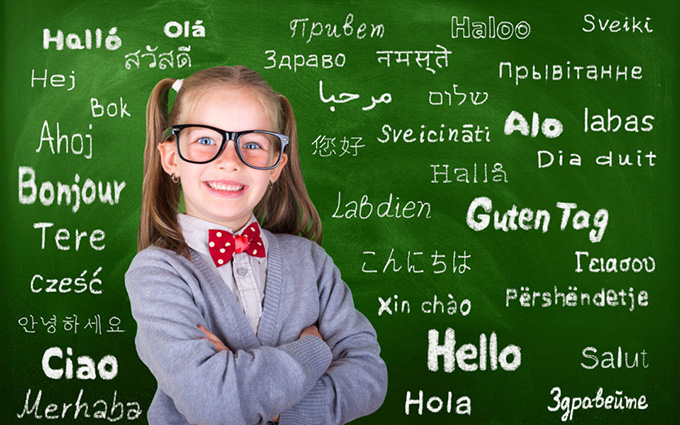
The families of young children who emigrate to another country, who are going to spend a long season abroad or are composed of mixed couples in which each parent has a different mother tongue end up inevitably asking the same question: When is the best time to start teaching a second language to our children?
This question may seem purely theoretical, but it is not. In many contexts, it is a serious problem that is difficult to address. Because each country’s policy influences foreigners, which includes socio-psychological, cultural and identity aspects.
Family Matter, State Issue
The truth is that when this question arises and they ask it to childhood professionals (teachers, psychologists, speech therapists …), what they are saying is: “Should we collaborate to make our child’s brain develop along of your life a rich and different thought or should we limit the development capabilities of your brain so that it grows with a unique thought and exactly the same as ours?
It is from this point that the linguistic war begins … and sometimes it becomes a personal matter.
From that moment on, the great dichotomy begins, a kind of linguistic warfare, something that ends up becoming a very personal matter for families.
Type responses
The arguments are varied. The opinion of pediatricians is usually: “That is too much for a child.” Meanwhile, speech therapists say: “If your child does not know the basic vocabulary we have created in our guides, he has a problem.” Most of the time, parents take the word of professionals to the letter.
On the other hand, there are schools. What is happening with the education system? How is this matter treated in a place that children attend daily? In some countries, the school system does not advise, but imposes, even exerts great pressure on families to discourage them from transmitting their mother tongue to children.
The arguments that are used are usually that the child will confuse the languages, will have difficulties to assimilate the academic contents, will repeat course, will have a delay in his learning, will open file to him… A scene of nightmare.
As a mother and linguist, for years I have heard stories of other mothers who regretted having moved their children away from their own languages and cultures, and testimonies of those who opted for dissimulation, hiding their children’s bi or trilingualism to certain institutions that They considered reluctant.
From opposite pedagogical approaches, the preferred response of open-minded educators to the question of when is the best time to teach children a second language is “as soon as possible”, which, certainly, is supported by research . However, here we must be careful with the words we use to designate this process.
Acquisition or learning
From a linguistic point of view, the study of learning differs completely from that of acquisition. The child’s language acquisition begins as soon as the auditory system sends data to the brain for treatment. On the contrary, learning a language requires the organization of voluntary mechanisms that require a lot of effort.
A child who is exposed to a second language at two, three, four or five years will have to make real efforts to integrate the set of structures that are part of the new linguistic system. This child, however, will be learning more easily than an adult.
What does science say?
- The study on “cardiac reactivity in the fetus” ( Lecanuet, Granier-Deferre, De Casper, Maugeais, Andrieu, Busnel, 1987 ) suggests that since the six months of the fetal stage the brain already processes speech sounds.
- On the other hand, a study on “the indications of auditory preference for the prosodic contours of the mother’s voice” ( Mehler, Bertoncini, Barrière et Jassik-Gerchenfeld, 1978 ) shows in the baby preferences related to intonation and fact that it is the voice of his mother, when the mother’s voice is presented in competition with that of another mother who speaks with her baby.
- Several experiments ( Jusczyk, 1985 ) showed that babies with three or four days of life can discriminate the voices and the mode of articulation that gives identity to each phoneme.
- The method of “high amplitude suction” ( E. Siqueland et C. Delucia in 1969 ) reveals that as of the fourth month, the baby can already differentiate the phonemes of his tongue by their acoustic difference: pa is different from ba , and also when “this difference places these syllables in one part and in another of a border close to the phonetic variations produced by adults.”
- Experiments have shown that at four and a half months, babies are more attentive to hearing their own name than the name of other babies, by the procedure of looking in the direction of who is pronouncing them ( Mandel, Jusczyk et Pisoni ).
- Also from the fourth month, the so-called “head rotation preference procedure” shows that the baby tends to turn the head to the side where he hears a familiar sound.
- In this same context, the baby is also able to discriminate the contrast between two syllables ( Werker et Tees ).
And what do these results suggest?
Well, a child who is repeatedly exposed to more than one linguistic system in his last months in the womb will have acquired more than one language naturally and effortlessly.
In addition, a very important factor must be taken into account: these studies are based on experiments performed on fetuses and babies of the eighties … How will it work in the brain of fetuses in 2018?
Author Bio: Yelly Hernandez is Doctor at Sciences of Language, Laboratory MoDyCo at the University Paris Descartes
